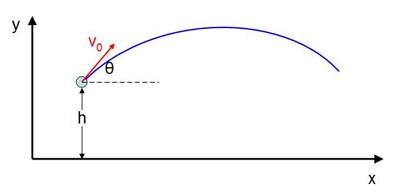Question #c8ae1
1 Answer
!! LONG ANSWER !!
Initial velocity :
Maximum height:
Landing speed:
Explanation:
So, you know that the cork is launched from an initial height of 1.2 m, and that it takes 2 seconds until it lands 5 m away from its initial position.
The fact that it doesn't fall in the exact same place from which it was launched tells you that it was launched at an angle, let's say

The initial velocity of the cork will thus have two components, a vertical one and a horizontal one.
In order to determine the angle of launch, you're going to have to use two equations, one tha describes the cork's horizontal motion and one that describes its vertical motion.
Horizontally, the cork moves without being acted upon by exterior forces. This means that you can use the horizontal displacement and total time of travel to write the vertical component of the initial velocity.
Vertically, things are a little more complicated. This time, the cork is acted upon by the force of gravity, which implies that the vertical component of its initial velocity will be affected by the gravitational acceleration,
Because the cork is launched from a height of 1.2 m, but ends up at ground level, the total vertical displacement will be equal to -1.2 m.
Think of it like this: if the 1.2-m height is set as the zero level, then the cork ends up 1.2 m lower than that, hence the negative sign.
This means that you can write
So, you have two equations with two unknowns
Divide the bottom one by the top one to get
This means that the initial velocity was
To get the maximum height of the cork, use the fact that, at the peak of its trajectory, right before it starts to drop towards the ground, the horizontal component of its velocity will be equal to zero.
The cork takes 0.94 seconds to reach the peak of its trajectory, which implies that it falls for
The height it reaches right before starting to drop will be
To get the final velocity of the cork, use the time it takes for the cork to drop to determine the vertical component of its final velocity. Once again, the fact that the vertical component of its velocity is zero at maximum height will come to your aid.
The horizontal component of its final velocity will be equal to that of the initial velocity. Finally, use Pythagoras' theorem to determine the final velocity

